Photog, blogger, gamer freak. Gaming, punk rock, autumn, vikings, halloween, LOTS of bioware fandom stuff, and pretty things.
Don't wanna be here? Send us removal request.
Text

Writing with Color: Description Guide - Words for Skin Tone
We discussed the issues describing People of Color by means of food in Part I of this guide, which brought rise to even more questions, mostly along the lines of “So, if food’s not an option, what can I use?” Well, I was just getting to that!
This final portion focuses on describing skin tone, with photo and passage examples provided throughout. I hope to cover everything from the use of straight-forward description to the more creatively-inclined, keeping in mind the questions we’ve received on this topic.
So let’s get to it.
S T A N D A R D D E S C R I P T I O N
B a s i c C o l o r s

Pictured above: Black, Brown, Beige, White, Pink.
“She had brown skin.”
This is a perfectly fine description that, while not providing the most detail, works well and will never become cliché.
Describing characters’ skin as simply brown or beige works on its own, though it’s not particularly telling just from the range in brown alone.
C o m p l e x C o l o r s
These are more rarely used words that actually “mean” their color. Some of these have multiple meanings, so you’ll want to look into those to determine what other associations a word might have.

Pictured above: Umber, Sepia, Ochre, Russet, Terra-cotta, Gold, Tawny, Taupe, Khaki, Fawn.
Complex colors work well alone, though often pair well with a basic color in regards to narrowing down shade/tone.
For example: Golden brown, russet brown, tawny beige…
As some of these are on the “rare” side, sliding in a definition of the word within the sentence itself may help readers who are unfamiliar with the term visualize the color without seeking a dictionary.
“He was tall and slim, his skin a russet, reddish-brown.”
Comparisons to familiar colors or visuals are also helpful:
“His skin was an ochre color, much like the mellow-brown light that bathed the forest.”
M o d i f i e r s
Modifiers, often adjectives, make partial changes to a word.The following words are descriptors in reference to skin tone.
D a r k - D e e p - R i c h - C o o l
W a r m - M e d i u m - T a n
F a i r - L i g h t - P a l e
Rich Black, Dark brown, Warm beige, Pale pink…
If you’re looking to get more specific than “brown,” modifiers narrow down shade further.
Keep in mind that these modifiers are not exactly colors.
As an already brown-skinned person, I get tan from a lot of sun and resultingly become a darker, deeper brown. I turn a pale, more yellow-brown in the winter.
While best used in combination with a color, I suppose words like “tan” “fair” and “light” do work alone; just note that tan is less likely to be taken for “naturally tan” and much more likely a tanned White person.
Calling someone “dark” as description on its own is offensive to some and also ambiguous. (See: Describing Skin as Dark)
U n d e r t o n e s
Undertones are the colors beneath the skin, seeing as skin isn’t just one even color but has more subdued tones within the dominating palette.

Mentioning the undertones within a character’s skin is an even more precise way to denote skin tone.
As shown, there’s a difference between say, brown skin with warm orange-red undertones (Kelly Rowland) and brown skin with cool, jewel undertones (Rutina Wesley).
“A dazzling smile revealed the bronze glow at her cheeks.”
“He always looked as if he’d ran a mile, a constant tinge of pink under his tawny skin.”
Standard Description Passage
“Farah’s skin, always fawn, had burned and freckled under the summer’s sun. Even at the cusp of autumn, an uneven tan clung to her skin like burrs. So unlike the smooth, red-brown ochre of her mother, which the sun had richened to a blessing.”
-From my story “Where Summer Ends” featured in Strange Little Girls
Here the state of skin also gives insight on character.
Note my use of “fawn” in regards to multiple meaning and association. While fawn is a color, it’s also a small, timid deer, which describes this very traumatized character of mine perfectly.
Though I use standard descriptions of skin tone more in my writing, at the same time I’m no stranger to creative descriptions, and do enjoy the occasional artsy detail of a character.
C R E A T I V E D E S C R I P T I O N
Whether compared to night-cast rivers or day’s first light…I actually enjoy seeing Characters of Colors dressed in artful detail.
I’ve read loads of descriptions in my day of white characters and their “smooth rose-tinged ivory skin”, while the PoC, if there, are reduced to something from a candy bowl or a Starbucks drink, so to actually read of PoC described in lavish detail can be somewhat of a treat.
Still, be mindful when you get creative with your character descriptions. Too many frills can become purple-prose-like, so do what feels right for your writing when and where. Not every character or scene warrants a creative description, either. Especially if they’re not even a secondary character.
Using a combination of color descriptions from standard to creative is probably a better method than straight creative. But again, do what’s good for your tale.
N A T U R AL S E T T I N G S - S K Y

Pictured above: Harvest Moon -Twilight, Fall/Autumn Leaves, Clay, Desert/Sahara, Sunlight - Sunrise - Sunset - Afterglow - Dawn- Day- Daybreak, Field - Prairie - Wheat, Mountain/Cliff, Beach/Sand/Straw/Hay.
Now before you run off to compare your heroine’s skin to the harvest moon or a cliff side, think about the associations to your words.
When I think cliff, I think of jagged, perilous, rough. I hear sand and picture grainy, yet smooth. Calm. mellow.
So consider your character and what you see fit to compare them to.
Also consider whose perspective you’re describing them from. Someone describing a person they revere or admire may have a more pleasant, loftier description than someone who can’t stand the person.
“Her face was like the fire-gold glow of dawn, lifting my gaze, drawing me in.”
“She had a sandy complexion, smooth and tawny.”
Even creative descriptions tend to draw help from your standard words.
F L O W E R S
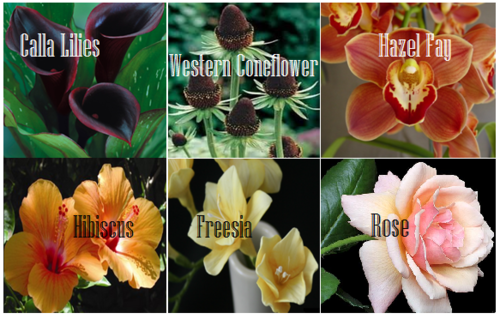
Pictured above: Calla lilies, Western Coneflower, Hazel Fay, Hibiscus, Freesia, Rose
It was a bit difficult to find flowers to my liking that didn’t have a 20 character name or wasn’t called something like “chocolate silk” so these are the finalists.
You’ll definitely want to avoid purple-prose here.
Also be aware of flowers that most might’ve never heard of. Roses are easy, as most know the look and coloring(s) of this plant. But Western coneflowers? Calla lilies? Maybe not so much.
“He entered the cottage in a huff, cheeks a blushing brown like the flowers Nana planted right under my window. Hazel Fay she called them, was it?”
A S S O R T E D P L A N T S & N A T U R E

Pictured above: Cattails, Seashell, Driftwood, Pinecone, Acorn, Amber
These ones are kinda odd. Perhaps because I’ve never seen these in comparison to skin tone, With the exception of amber.
At least they’re common enough that most may have an idea what you’re talking about at the mention of “pinecone."
I suggest reading out your sentences aloud to get a better feel of how it’ll sounds.
"Auburn hair swept past pointed ears, set around a face like an acorn both in shape and shade.”
I pictured some tree-dwelling being or person from a fantasy world in this example, which makes the comparison more appropriate.
I don’t suggest using a comparison just “cuz you can” but actually being thoughtful about what you’re comparing your character to and how it applies to your character and/or setting.
W O O D

Pictured above: Mahogany, Walnut, Chestnut, Golden Oak, Ash
Wood can be an iffy description for skin tone. Not only due to several of them having “foody” terminology within their names, but again, associations.
Some people would prefer not to compare/be compared to wood at all, so get opinions, try it aloud, and make sure it’s appropriate to the character if you do use it.
“The old warlock’s skin was a deep shade of mahogany, his stare serious and firm as it held mine.”
M E T A L S

Pictured above: Platinum, Copper, Brass, Gold, Bronze
Copper skin, brass-colored skin, golden skin…
I’ve even heard variations of these used before by comparison to an object of the same properties/coloring, such as penny for copper.
These also work well with modifiers.
“The dress of fine white silks popped against the deep bronze of her skin.”
G E M S T O N E S - M I N E R A LS

Pictured above: Onyx, Obsidian, Sard, Topaz, Carnelian, Smoky Quartz, Rutile, Pyrite, Citrine, Gypsum
These are trickier to use. As with some complex colors, the writer will have to get us to understand what most of these look like.
If you use these, or any more rare description, consider if it actually “fits” the book or scene.
Even if you’re able to get us to picture what “rutile” looks like, why are you using this description as opposed to something else? Have that answer for yourself.
“His skin reminded her of the topaz ring her father wore at his finger, a gleaming stone of brown, mellow facades.”
P H Y S I C A L D E S C R I P T I ON
Physical character description can be more than skin tone.
Show us hair, eyes, noses, mouth, hands…body posture, body shape, skin texture… though not necessarily all of those nor at once.
Describing features also helps indicate race, especially if your character has some traits common within the race they are, such as afro hair to a Black character.
How comprehensive you decide to get is up to you. I wouldn’t overdo it and get specific to every mole and birthmark. Noting defining characteristics is good, though, like slightly spaced front teeth, curls that stay flopping in their face, hands freckled with sunspots…
G E N E R A L T I P S
Indicate Race Early: I suggest indicators of race be made at the earliest convenience within the writing, with more hints threaded throughout here and there.
Get Creative On Your Own: Obviously, I couldn’t cover every proper color or comparison in which has been “approved” to use for your characters’ skin color, so it’s up to you to use discretion when seeking other ways and shades to describe skin tone.
Skin Color May Not Be Enough: Describing skin tone isn’t always enough to indicate someone’s ethnicity. As timeless cases with readers equating brown to “dark white” or something, more indicators of race may be needed.
Describe White characters and PoC Alike: You should describe the race and/or skin tone of your white characters just as you do your Characters of Color. If you don’t, you risk implying that White is the default human being and PoC are the “Other”).
PSA: Don’t use “Colored.” Based on some asks we’ve received using this word, I’d like to say that unless you or your character is a racist grandmama from the 1960s, do not call People of Color “colored” please.
Not Sure Where to Start? You really can’t go wrong using basic colors for your skin descriptions. It’s actually what many people prefer and works best for most writing. Personally, I tend to describe my characters using a combo of basic colors + modifiers, with mentions of undertones at times. I do like to veer into more creative descriptions on occasion.
Want some alternatives to “skin” or “skin color”? Try: Appearance, blend, blush, cast, coloring, complexion, flush, glow, hue, overtone, palette, pigmentation, rinse, shade, sheen, spectrum, tinge, tint, tone, undertone, value, wash.
Skin Tone Resources
List of Color Names
The Color Thesaurus
Things that are Brown (blog)
Skin Undertone & Color Matching
Tips and Words on Describing Skin
Photos: Undertones Described (Modifiers included)
Online Thesaurus (try colors, such as “red” & “brown”)
Don’t Call me Pastries: Creative Skin Tones w/ pics 3 2 1
Writing & Description Guides
WWC Featured Description Posts
WWC Guide: Words to Describe Hair
Writing with Color: Description & Skin Color Tags
7 Offensive Mistakes Well-intentioned Writers Make
I tried to be as comprehensive as possible with this guide, but if you have a question regarding describing skin color that hasn’t been answered within part I or II of this guide, or have more questions after reading this post, feel free to ask!
~ Mod Colette
170K notes
·
View notes
Text


He was so upset i made my character hold his hand for a while
17K notes
·
View notes
Text
407K notes
·
View notes
Text
Witchy *Free* PDF book list Masterpost
Hey lovely witches! I wanted to share some of my PDF witchy books I have on my computer. I know it’s hard to find these books and not everyone has money to buy them or easy access. I hope I can help someone with this <3
Most of the books are on my google drive library, you can click on the link and then download if you’d like to.
A Manual of Occultism, by Sepharial
Mastering Witchcraft, by Paul Huson
Natural Magic, by Pamela J.Ball
Pagan Spells, Author Unknown
Herbal Magick - Herbal enchantments, folclore and divination by Gerina Dunwich <3
Spell Crafts - Creating magical objects, by, Scott Cunningham and David Harrington <3
The Book of Power, by Idres Shah
The Complete book of Incense, Oils ad Brews, by Scott Cunningham
The Essential Skills of Magick - Benjamim Rowe
The Ultimate Book of Spells - Pamela J. Ball *my favorite spellbook*
50 of The Most Powerful Spells, by unknown author
Witchcraft Today, by Gerald Gardner
The Gardnerian Book of Shadows
The Basics of Magic, by K. Amber
8 Sabbaths of Witchcraft, by Mike Nichols
Witchcraft Today, by Gerald Gardner
Celtic Mythology and Religion, by Alexander Macbain
The Art and meaning of Magic, By Israel Regardie
An Introduction to the Study of Tarot, by Paul Foster Case
The Alchemy of Abundance, by Lisa McSherry
Encyclopedia of Acient Roman and Greek Mythology, by James Belton
Asgard and the Gods, by M. W. MacDowall,
The Ultimate Encyclopedia of Spells by, Michael Johnstone
Witches’ Bible by, Janet and Stewart Farrar
The Witch’s Master Grimoire, by Lady Sabrina
The meaning of Witchcraft, by Gerald Gardner
Aleister Crowley book collection (google drive)
Lid Off the Cauldron, by Patricia Crowther
A Grimoire for Modern Cunningfolk, by Peter Paddon
The A to Z of Dream Interpretation, by Pamela J. Ball
The Dream Oracle, by Pamela J. Ball
The Great Book of Spells, by Pamela J. Ball <3
The Techniques of Astral Projection, By Dr. Douglas M. Baker
The Opening of the Third Eye, By Dr. Douglas M. Baker
Historical Dictionary of Witchcraft, By Bailey Michael
The Goddess is in Details, by Deborah Blake <3
Circle, Coven and Grove, by Deborah Blake
A Witch’s Dozen, by Deborah Blake <3
Witchcraft on a Shoestring by Deborah Blake
Egyptian Magic, By Ernest Budge
Advanced Candle Magick, By Raymond Buckley
Amulets and Magic, By Budge Walli
Pen and Ink Witchcrafr , By Collin Calloway
Basic Sigil Magic, By Philip Cooper
The Occult Properties of Herbs , By W.B Crow
Shadow Work Guidebook, by Jessica Cross
Gemstone Sorcery, By Gerina Dunwich <3
Wicca A to Z By Gerina Dunwich
Every Witch Way By Ellen Dugan <3
Power Of The Witch By Laurie Cabot <3
The Spiral Dance By Starhawk <3
Spiritual Power - Llewellyn Vaughan-Lee
Book of Shadows By, Phyllis Curott:
Witchcrafting By Phyllis Curott
Spells for the Solitary Witch By Eileen Holland
Wiccan Magick By Raven Grimassi
The Witch’s Familiar By Raven Grimassi
Magical Candle Crafting By Ember Grant
Magical Powder Recipes By Lady Gianne
Wicca For Beginners By Lisa Chamberlain
Scott Cunningham’s Books:
Divination for Beginners
Wicca in the Kitchen <3
Book of Shadows
Living Wicca
Crystal Gem and Metal Magick <3
Wicca
Encyclopedia of Magical Herbs
Magical Household, Rituals and spells for the home <3
D.J Conway’s Books:
Mystical Dragon
Norse Magic
Wicca, The Complete Craft
Falcon, Feather and Valkyrie Sword
Celtic Magic
Christopher Penczak’s Books
Gay Witchcraft - Christopher Penczak
The Living Temple of Witchcraft V. II- Christopher Penczak
The Gates of Witchcraft
The Living Temple of Witchcraft V.II
Mystic Foundation
The Outer Temple Of Witchcraft
The Inner Temple of Witchcraft
The Witch’s Shield
Cassandra Eason’s Books:
A Practical Guide of Witchcraft and Spells,
Fabulous Creatures, Mythical Monsters and Animal Power Symbols
Candle Power
The Art of Pendulum
The Complete Guide to Psychic Development
Illes Judika’s Books:
Magic When You Need It - 150 Spells
Pure Magic
The Element Encyclopedia of Witchcraft
Ellwood Taylor’s Books:
Pop Culture Magic
The Pop Culture Grimoire
Multi-Media Magic
Manifesting Prosperity
For those of you who wish to see my full library on the drive, feel free to send me a message and I will send you the link!
HAVE FUN! :)
99K notes
·
View notes
Photo

If you’ve been following development of Pixel Art Academy (here’s the devlog), you know I’ve been making my own tools to draw art for the game. Today is the first time I’ve used the sprite editor to just practice drawing.
I’ve devised a study plan for myself to become better at art in 2019, specifically I want to start drawing solar punk concept art. More about my plan here, and you can follow my progress daily on Instagram. The other day I started studying architecture styles and today I drew this building from Çatalhöyük, which was a Neolithic settlement in Turkey around 7000 BC.
My editor has infinite undo/redo, which means I can output a timelapse of the drawing process:

I’m also working on an advanced version of my drawing tool, called 3D Paint, that will eventually be able to draw realtime shadows, ambient occlusion, reflections, etc. This sprite was not drawn in that tool yet, but it was already painted in a way that is compatible with it. In particular, all the surfaces are dynamically shaded based on the direction they are turned towards (a.k.a. their normal vectors). This allows me to change the lighting of the scene on the fly:

Right now ambient occlusion is faked (hand-painted) and there are no cast shadows since full 3D geometry information isn’t there. But when I get 3D Paint fully operational, expect some more cool stuff.
158 notes
·
View notes
Photo



Dating from the early 17th century Huntington castle, Co. Carlow, is famous for it’s ancient row of yew trees
362 notes
·
View notes
Photo
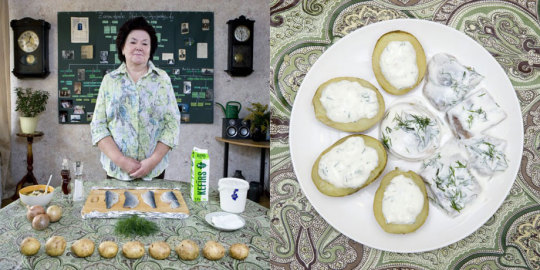

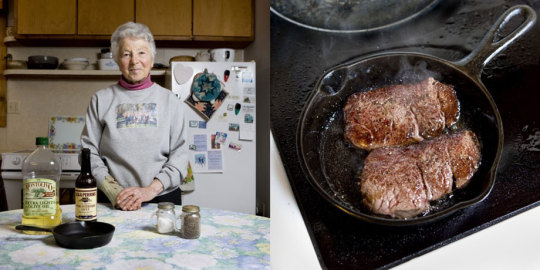


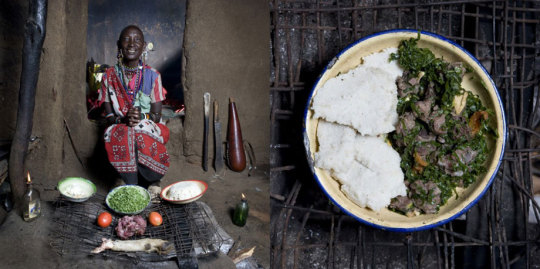


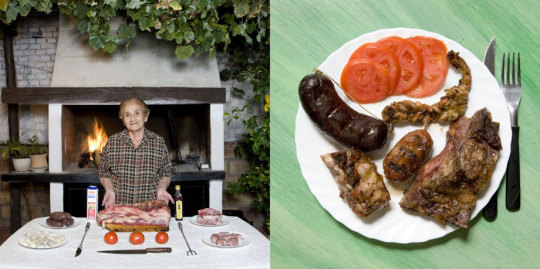

If grandmothers around the world had a rallying cry, it would probably sound something like “You need to eat!”
Photographer Gabriele Galimberti’s grandmother said something similar to him before one of his many globetrotting work trips. To ensure he had at least one good meal, she prepared for him a dish of ravioli before he departed on one of his adventures.
“In that occasion I said to my grandma ‘You know, Grandma, there are many other grandmas around the world and most of them are really good cooks,” Galimberti wrote via email. “I’m going to meet them and ask them to cook for me so I can show you that you don’t have to be worried for me and the food that I will eat!’ This is the way my project was born!”
The project, “Delicatessen With Love”, took Galimberti to 58 countries where he photographed grandmothers with both the ingredients and finished signature dishes.
He acted as photographer and stylist during each shoot with the grandmothers, taking a portrait of both the women and the food they made for him.
From top to bottom:
Inara Runtule, 68, Kekava, Latvia. Silke (herring with potatoes and cottage cheese). Grace Estibero, 82, Mumbai, India. Chicken vindaloo.
Susann Soresen, 81, Homer, Alaska. Moose steak.
Serette Charles, 63, Saint-Jean du Sud, Haiti. Lambi in creole sauce.
The photographer’s grandmother Marisa Batini, 80, Castiglion Fiorentino, Italy. Swiss chard and ricotta Ravioli with meat sauce.
Normita Sambu Arap, 65, Oltepessi (Masaai Mara), Kenya. Mboga and orgali (white corn polenta with vegetables and goat).
Julia Enaigua, 71, La Paz, Bolivia. Queso Humacha (vegetables and fresh cheese soup).
Fifi Makhmer, 62, Cairo, Egypt. Kuoshry (pasta, rice and legumes pie).
Isolina Perez De Vargas, 83, Mendoza, Argentina. Asado criollo (mixed meats barbecue).
Bisrat Melake, 60, Addis Ababa, Ethiopia. Enjera with curry and vegetables.
296K notes
·
View notes
Photo

“For long, long years I was a hawk. I knew every hill and stream; every field and glen of Ireland. I knew the shape of cliffs and coasts, and how all places looked under the sun or moon. And I was still a hawk when the sons of Mil drove the Tuatha De’ Danann under the ground, and held Ireland against arms or wizardry; and this was the coming of men and the beginning of genealogies.”
Tuan mac Cairill | Irish Mythology
200 notes
·
View notes
Photo

Gaelic traditional festival marking the beginning of spring.
Imbolc moodboard
Days and holidays: (4/?)
951 notes
·
View notes
Photo



Gold Tubular Collar from Lough Foyle, Northern Ireland dated to the 1st Century BCE on display at the National Museum of Ireland-Archaeology in Dublin
This tubular collar as well as a miniature boat, cauldron, two neck chains and a pair of twisted collars (torcs) were found on the ancient shore of Lough Foyle in County Derry. The sea god Manannán mac Lir was associated with Lough Foyle and the objects are thought to be offerings to the god. The decoration on the tubular collar appears to include a highly stylised horse, an animal that is especially associated with Manannán mac Lir.
Photographs taken by myself
2K notes
·
View notes













